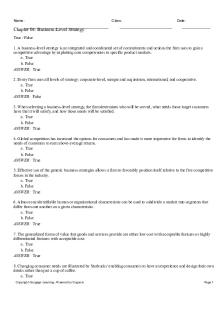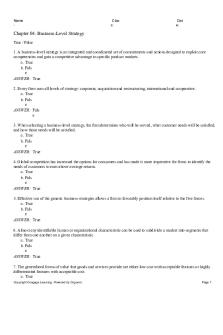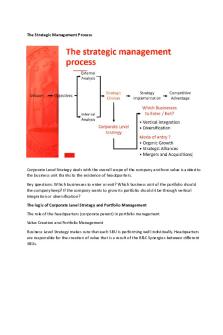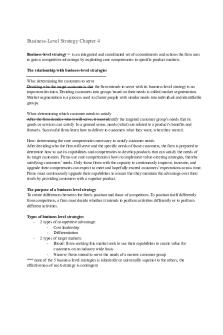CH 4 - Business Level Strategy PDF

| Title | CH 4 - Business Level Strategy |
|---|---|
| Course | Strategic Management |
| Institution | Langara College |
| Pages | 9 |
| File Size | 270.2 KB |
| File Type | |
| Total Downloads | 353 |
| Total Views | 428 |
Summary
CH 4 – Business Level Strategies 1. Define business level strategy 2. Relationship between customer and business level strategy a. Who b. What c. How 3. Different business level strategies 4. Use 5 forces of competition to explain how above average returns earned via each business level strategy 5. ...
Description
CH 4 – Business Level Strategies 1. Define business level strategy 2. Relationship between customer and business level strategy a. Who b. What c. How 3. Different business level strategies 4. Use 5 forces of competition to explain how above average returns earned via each business level strategy 5. Risk of each business level strategy
Making choices influenced by external (o/t) as well as internal (s/w) Having the right capabilities matching opportunities Strategies to gain strategic competitiveness and earn above average returns o Integrate, allocates resources and capabilities to align with external Business level strategy o How firm compete in individual product markets o Integrated and coordinated set of actions to gain competitive advantage by exploiting core competencies in specific product markets o Single product market in single geo location does not need corporate level strategies o Determine Who will be served What needs those target customers have that it will satisfy How those needs will be satisfied
Customers Relationship with Business Level Strategies
Find new ways to satisfy current customers Meet needs of new customers Difficult econ times o Focus on best customers o Flexible workforce
Effectively Managing Relationships with Customers
Strong interactive relationships with customers = profitably serve unique needs Customer satisfaction = repeat customers Knowledgeable customers = harder to gain loyalty
Reach, Richness and Affiliation (Help answer who, what, how)
Rich o Access and connection to customers o Extending reach = adding customers Richness o Depth and detail of two way info with customers o Why firms offer online services -> broader n deeper info exchanges To better understand customesr Affiliation o Facilitating useful interactions with customers o View customer’s POV and seeking new ways to create value o Data on individual customers allowing customized provices Who -> What -> How
Who: Determining the Customers to Serve
Market Segment o Dividing customers into groups based on their needs Customer markets o Demo factors(age, income, sex) o Socioeconomic factors (social class, stage in family cycle) o Geo factors (cultural, regional, national) o Psycho factors (lifestyle, personality traits) o Consumption patterns (heavy, moderate, light) o Perceptual factors (benefit, perceptual map) Industrial markets o End-use segments (Standard Industrial Classification) o Product segments (based on tech diff or production economies) o Geo segments (country or region) o Common buying factor segments (cut across product/geo markets) o Customer size segments
What: Determining Which Customer Needs to Satisfy
Product’s benefits and features Close and often interactions with customers help know their needs Use of data and info Create value: low cost with acceptable features or highly differentiated with acceptable cost Must continuously anticipate change in customer needs
How: Determining Core Competencies Necessary to Satisfy Customer Needs
How to use capabilities and competencies to develop products to satisfy needs Firms who continue to improve and upgrade competencies can exceed customer expectations Innovation, R&D, data and info
Purpose of Business Level Strategy
Purpose = create differences between firm’s position and rivals’ o Decide to perform activities differently or perform different activities Choice about how firm will perform value chain and support activities to create unique value Successful use of bz lvl strat = how to integrate activities o Eg) Southwest Airlines (Cost leadership) Limited passenger service supported by no meals, no seat assignments, no baggage transfer Low prices at acceptable levels of differentiation (engaging culture) Effectively integrating activities make it difficult for rivals to imitate
Types of Business Level Strategy
Each strategy exploits a competitive advantage in a competitive scope How firms integrate activities within a strategy differs from one another o Increases likelihood of gaining competitive advantage and above avg returns Lower cost: ability to perform activities differently Differentiate: perform different (valuable) activities for premium price Using either one depends on nature and quality of resources/capabilities/core competencies Broad Market: use capabilities to create value to customers industry wide basis Narrow Market: serve needs of a segment in an industry (focused strategy) Integrated Cost Leadership/Differentiation: combined low cost/distinctiveness & larger narrow/ smaller broad Effectiveness on each strategy depends on SWOT o Matching O/T to S (based on core competencies)
Cost Leadership Strategy
Acceptable features at lowest cost (compared to rival’s) Usually standardized goods with levels of differentiation to most typical customer Process innovation (New production and distribution methods) allow this strategy Sourcing strategies and find low-cost suppliers outsourced Inbound logistics (materials handling/ warehouse/ inventory control) & outbound logistics (collect/ store/ distribute) -> creates value with this strategy (outsourcing to China)
Support Functions for Cost Leadership Strategy Finance Manage financial resources for positive cash flow and low debt costs
Human Resources Develop policies to ensure efficient hiring and retention to keep costs low.
MIS Develop and maintain costeffective MIS operatoins
Training for efficiency Value Chain Activities for Cost Leadership Strategy Supply Chain Relationships with suppliers for efficient flow of goods
Operations Build economies of scale and efficient operations (production process)
Distribution Use of low-cost modes of transporting goods and delivery times that produce lowest costs
Marketing Targeted advertising and low prices for high sale volume
Follow-up Service Efficient follow-up to reduce returns
↓How to implement a Cost Leadership Strategy ↓ Rivalry with Existing Competitors Based on size and resources of rivals, dependence on market Rivals hesitate to compete on price Firms form joint ventures to reduce rivalry and increase profitability Bargaining Power of Buyers Powerful customers able to further reduce prices (not so that next rival earns above avg) Prices low enough to prevent next rival from earning above avg = exit = less competition o Customers then lose power because less competition o Some customers force innovative provice instead Build trust and obtain info to produce products superior in value
Bargaining Power of Suppliers Having higher margins allow absorb supplier’s price increase Powerful cost leader able to force supplier to hold down prices Walmart reduce number & type of products = reduce its bargaining power with suppliers o Unable to get best prices Some firms outsource and create dependencies on suppliers (supplier demands larger share) o Must build trust with supplier Potential Entrants Efficiency = economies of scale o Barrier for new entrants o New entrants must accept lower returns until they gain experience Lower margins than distinctive strategy = must sell high volumes to earn above avg Must avoid pricing so low that there’s no profit Product Substitute Becomes concern when features (cost and differentiation) are attractive to customers Cost leader can lower prices even more = increases likelihood still choose them Competitive Risks of Cost Leadership Strategy Competitor innovating new processes to produce and distribute (making old obsolete) o Allow rival to produce more cheap or add new differentiation without higher cost Too focused on cost reduction & not understand “competitive levels of differentiation” o What is acceptable? (Walmart too few salespeople on floor) Imitation – rivals learn to use own core competencies and successfully imitate o Firm forced to create more value by lower prices or add differentiated features at higher cost while selling same price
Differentiation Strategy
Provice that customers perceive as being different and important to them (at acceptable cost) Target customers who value differentiated products (vs typical customer as cost leader) Product innovation (new way to solve customer’s problem) important for differentiators Must be able to produce at competitive cost (customers willing to pay) Must understand what target customers value (what they are willing a premium for) o Differentiated features over low cost o Reliability/ durability/ high-performance Lexus Apply knowledge capital to provide differentiated products Maintain success by continually upgrading differentiated features or innovate new ones without much extra cost (keep changing product lines) Portfolio of complementary products (more differentiation) Invest in developing features that will differentiate Linking value chain activities to achieve differentiation strategy
Support Functions for Differentiation Strategy Finance Long-term investment in developing new tech/ innovate products, marketing, service
Human Resources Recruit highly qualified
MIS Up-to-date market intelligence
Invest in training for latest tech knowledge & capabilities
Real time info for strategic & major operational decisions
Value Chain Activities for Differentiation Strategy Supply Chain Positive with major suppliers Ensure getting high quality supplies
Operations Flexible production processes to respond to changing needs
Distribution Accurate and timely delivery
Marketing Strong positive relationship with customers
Follow-up Service Specially trained for post-service to ensure satisfaction
Invest in effective promo and advertising programs
↓How to position, using a Differentiation Strategy ↓ Rivalry with Existing Competitors Customers usually loyal to brands and less sensitive to prices o Insulates from competitive rivalry Reputation can sustain competitive advantage for differentiators Must be careful with imitators who can improve on products with valuable features Bargaining Power of Buyers Customer accept price increases when still satisfying needs better than competitor More likely to think there’s no acceptable alternative product Bargaining Power of Suppliers Must provide high quality inputs -> drive up firm’s cost Higher margins partially insulates from higher supplier prices o Higher supplier costs covered by firm’s higher margins o Or pass additional cost to customers (less sensitive to price) Outsourcing functions like R&D to suppliers increase dependency on suppier Potential Entrants Barriers= customer loyalty and need to overcome uniqueness of differentiated products o Require investing of resources and patience to build customer loyalty Some new entrants make small investment to see if they gain any foothold and use rest of it to enhance competitive position
Product Substitutes Loyal customers prevent switching (no loyalty = switch for lower price or more features) Vulnerable to innovations outside of industry (Apple iPod in music industry) Competitive Risk of Differentiation Strategy Customers decide price diff between differentiator and cost leader too big o Means differentiated features exceeding customer needs Vulnerable to firms who offer combo of price and features consistent with needs Differentiation provide no value for the price willing to pay for o If customers perceive rival has same goods but at lower price Good experiences with a more generic product = not worth extra cost Counterfeits = distrust with customers
Focus Strategies
Focus strategy: provice serving needs of a particular competitive segment/ niche exclusively o Particular buyer group (youth vs senior) o Diff segment of product line (professional vs DIY group) o Diff geo market Exploiting narrow target’s differences from the typical industry o Serving a particular segment more effectively than industry-wide rivals Same value/support activities and 5 forces as industry wide strategies
Focused Cost Leadership Strategy
IKEA – target young buyers desiring style at low costs o Activities to keep cost low Own engineer design low-cost ready to assemble products Eliminate sales by laying out in showrooms Self delivery o But has differentiating features In-store playroom Extended hours
Focused Differentiation Strategy
Organic food trucks
Competitive Risks of Focus Strategies
Same as industry wide strategies + 3 more 1. Competitor finding a narrower segment a. Additional differentiating features at same price or same at lower price 2. Industry wide firm decides to pursue focused segment 3. Needs of narrow market become similar to industry wide ones
Integrated Cost Leadership/ Differentiation Strategy
Pursue both Efficiently produce products with some differentiated features Efficient production Adapt quickly to new tech and changes in external environ More value chain and support activities required to be competent in Flexible value chain and support activities required o manufacturing systems o Info networks o Total quality managemtn systems Caught in middle (cannot do either well) Emerging market firms have lower labour cost and gaining capabilities for innovation
Flexible Manufacturing Systems
Flexible manufacturing system (FMS) o Produce variety of products in moderate flexible quantities w/ min. intervention o Integrate human, physical and info resources o Eliminate low-cost vs variety trade off in manufacturing
Information Networks
Linking companies with their supplier/distributor/customer information = flexibility o Help satisfy customer expectation (quality and delivery speed) CRM – allow firms determine cost and differentiation trade offs customers willing to make Managing supply chains – help firm predict future scenarios
Total Quality Management Systems
Managerial process continuous improvement of all processes through problem solving approaches based on empowering employees Increases customer satisfaction/ cut costs/ reduce time to intro innovative products Benefits cost leaders more when TQM used alone
Competitive Risks of Integrated Cost Leadership/ Differentiation Strategy
Difficult to achieve Stuck in the middle (not low enough prices, not differentiated enough products) Industry wide firms stuck in the middle when fail at cost leader or differentiator Firms more successful if just pick one...
Similar Free PDFs

CH 4 - Business Level Strategy
- 9 Pages

3 - Business level strategy
- 3 Pages

Business Level strategy
- 14 Pages

Business level strategy Samsung
- 5 Pages

Chapter 04 Business Level Strategy
- 21 Pages

Chapter 04 Business Level Strategy
- 25 Pages

CH 6 - Corporate Level Strategy
- 9 Pages

3. Corporate Level Strategy
- 18 Pages
Popular Institutions
- Tinajero National High School - Annex
- Politeknik Caltex Riau
- Yokohama City University
- SGT University
- University of Al-Qadisiyah
- Divine Word College of Vigan
- Techniek College Rotterdam
- Universidade de Santiago
- Universiti Teknologi MARA Cawangan Johor Kampus Pasir Gudang
- Poltekkes Kemenkes Yogyakarta
- Baguio City National High School
- Colegio san marcos
- preparatoria uno
- Centro de Bachillerato Tecnológico Industrial y de Servicios No. 107
- Dalian Maritime University
- Quang Trung Secondary School
- Colegio Tecnológico en Informática
- Corporación Regional de Educación Superior
- Grupo CEDVA
- Dar Al Uloom University
- Centro de Estudios Preuniversitarios de la Universidad Nacional de Ingeniería
- 上智大学
- Aakash International School, Nuna Majara
- San Felipe Neri Catholic School
- Kang Chiao International School - New Taipei City
- Misamis Occidental National High School
- Institución Educativa Escuela Normal Juan Ladrilleros
- Kolehiyo ng Pantukan
- Batanes State College
- Instituto Continental
- Sekolah Menengah Kejuruan Kesehatan Kaltara (Tarakan)
- Colegio de La Inmaculada Concepcion - Cebu







